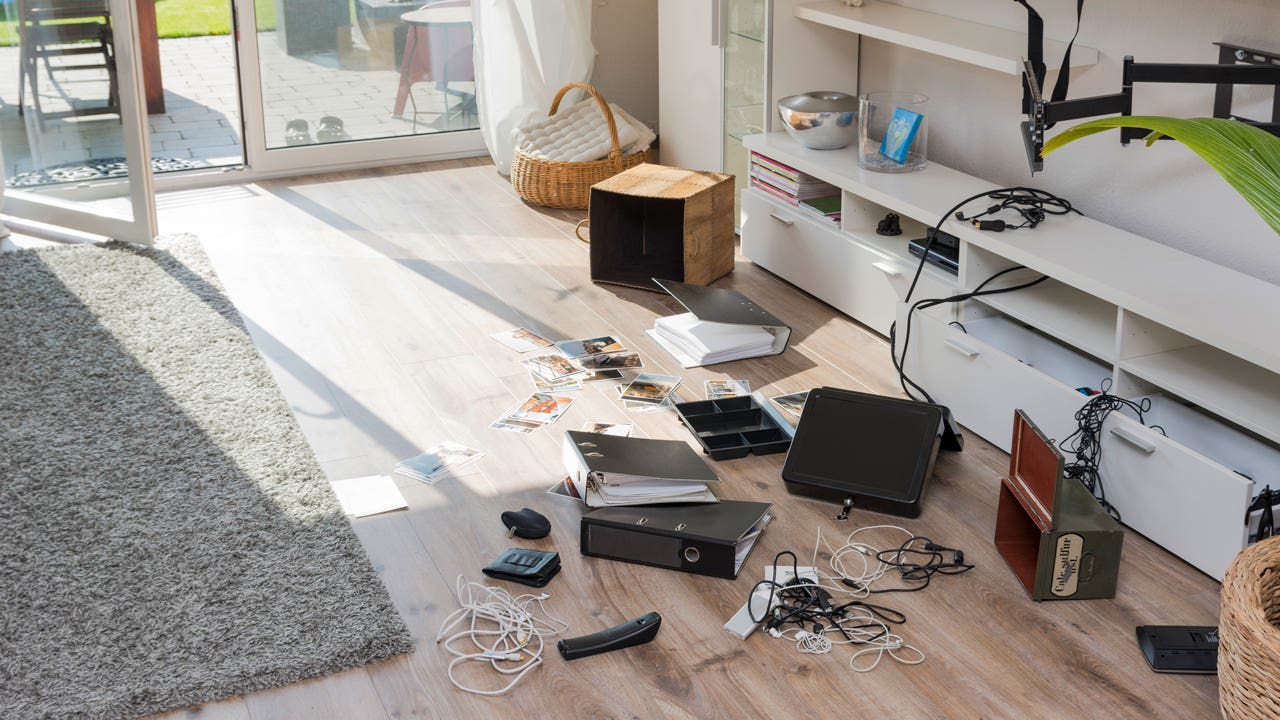Burglary statistics 2024

The Bankrate promise
At Bankrate, we strive to help you make smarter financial decisions. To help readers understand how insurance affects their finances, we have licensed insurance professionals on staff who have spent a combined 47 years in the auto, home and life insurance industries. While we adhere to strict , this post may contain references to products from our partners. Here's an explanation of . Our content is backed by Coverage.com, LLC, a licensed entity (NPN: 19966249). For more information, please see our .
According to SafeWise’s 2023 State of Safety in America report, burglaries are the most worrisome property crime for Americans. And the concern is a valid one — new burglaries happen at a rate of two per minute in the U.S. Fortunately, there are steps you can take to prevent burglary on your property and reduce your risk of becoming a victim of this type of crime.
Key burglary statistics
The FBI maintains a crime database that tracks the data of various crimes in the United States, including burglary statistics and, more specifically, home invasion statistics.
- 847,522 burglaries were reported to the FBI in 2022, an increase over the number reported in 2021. The annual number is still down from any point over the last decade, however. (FBI Crime Data)
- 239,137 counts happened during the day at the victim’s residence.
- 184,846 counts happened at night at the victim’s residence.
- In 2022, total stolen property value in the U.S. was estimated at $463,576,405,747, with only $38,983,319,655 of that value recovered. (FBI Crime Data)
- Between the first half of 2022 and the first half of 2023, residential burglary rates dropped by 3.8 percent. (Council on Criminal Justice)
- Burglars are drawn to homes that do not have home security systems. Homes that don’t have a security system are 300 percent more likely to be burglarized. (Alarms.org)
- 50 percent of burglars live within two miles away from the home they want to steal from. (ADT)
- The average home burglary experiences a loss of $2,661. (SafeWise)
- Most burglaries occur in the summer. (Department of Justice)
- Approximately 60 percent of burglars said they would seek an alternative target if an alarm system were on-site at their initial target. (UNC Charlotte)
- 41 percent of burglaries are spur-of-the-moment, while 12 percent are planned in advance. (UNC Charlotte)
- Both men and women are at nearly-equal risk of being the victim of burglary, with men slightly more at risk (54 percent of burglary victims are men). (FBI Crime Data)
What is burglary and home invasion?
Burglary is a very specific crime that involves a person making an unlawful entry into a structure with the intent to commit a separate felony or theft. The crime is frequently referred to as “breaking and entering,” although the entry into a structure does not need to be physically violent. Burglary can occur in connection with any structure, including a business or even an airplane. Home invasion involves the act of breaking into an occupied residence with the specific intent of terrorizing, harming or committing another crime the people inside.
In the eyes of the law, burglary has varying degrees of severity. First-, second- and third-degree burglaries are typically classified as felonies. A fourth-degree burglary, if it is recognized as such, is usually a misdemeanor. Keep in mind that the exact degrees of burglary and their associated penalties vary by state.
- First-degree burglary: The most serious, first-degree burglary involves possession of a deadly weapon with the intent to commit theft or a violent crime against the victim inside.
- Second-degree burglary: Second-degree burglary is similar to first-degree burglary, but involves entering a non-residence such as a business premise or buildings detached from homes such as sheds.
- Third-degree: This is a type of burglary without the violent consequences, often charged when there is a break-in but it is not clear why the person broke in.
- Fourth-degree: This kind of burglary generally involves removing items from areas surrounding homes and businesses such as fenced-in yards.
Burglary statistics over time
Burglary is a form of home invasion that has evolved as a very specific and defined crime in the United States, with varying degrees of severity. Data from the FBI shows a small, but steady, decline in the number of burglaries over the past several years.
| Year | Burglaries | Burglaries to residential homes |
|---|---|---|
| 2022 | 847,522 | 57% |
| 2021 | 671,648 | 60% |
| 2020 | 940,358 | 62% |
| 2019 | 1,011,890 | 68% |
| 2018 | 1,116,963 | 69% |
What you need to know about burglary
The fact that burglaries are declining on the whole is good news for homeowners. The burglary rate in the United States is currently less than one-fifth of what it was in 1980.
When do burglaries happen?
Although many might assume that most burglaries naturally occur at night when burglars can operate under the cover of darkness, in fact, the opposite is true. According to ADT, the majority of burglaries happen during the day when parents are at work and children are at school, usually from 10 a.m. – 3 p.m., and especially around lunchtime.
Burglaries are more likely to occur in urban settings. The size of a community makes a difference, as crime rates are generally higher in urban than rural areas. The rates of both property and violent crime are three to four times greater in the largest U.S. cities than rural rates.
Past studies by the Justice Department revealed that burglary victims knew the burglar 30 percent of the time and the burglar was a stranger in 24 percent of the crimes. Most of the time (46 percent), the burglar’s identity was never established.
Who do burglaries happen to?
According to property crime data from the FBI, burglaries in the United States are most likely to happen on private residential properties. Southern states consistently demonstrate a higher risk for burglary than those in the Northeast, according to software company The Porch Group, with currency and jewelry the most frequently-targeted types of property.
Based on 2019 crime report data, rural areas are at higher risk than more densely populated cities. Historically, renters have been at a higher risk than homeowners for burglary, as shown by data from the U.S. Department of Justice. However, that gap is closing. SafeWise found that the rate is nearly even as of its 2023 State of Safety Report, showing that 28 percent of renters experience property crime compared to 27 percent of homeowners.
Analysis of the National Crime Victimization Survey (NCVS) from the Bureau of Justice Statistics shows that across all regions of the United States in 2022, households with a combined income over $75,000 are at the lowest risk of burglary. Households with incomes totaling less than $25,000 a year are at a higher risk of victimization overall. And the largest households — those with six or more residents — are at higher risk than single- or dual-resident properties.
How do burglaries happen?
While burglaries have declined over the past years, understanding how burglaries occur can help in prevention efforts.
Home security company ADT reports that in 34 percent of burglaries, offenders simply twist the doorknob of their target house and walk inside. Another 23 percent access the home through an open first-floor window. This ease of access points to many burglaries being a crime of convenience. And burglaries take much less time than most people assume — on average, only eight to 10 minutes, per the FBI.
Burglary statistics state-by-state
- The tables below provide a current snapshot of burglary prevalence across the country.
- In 2019, the estimated number of burglaries declined in every region of the country — 13.5 percent in the Northeast, 10.3 percent in the Midwest, 9.4 percent in the West and 8.4 percent in the South. (FBI)
- The overall decline of burglaries for the United States for this period was 9.9 percent . (FBI)
- This pattern of decline was similar for all property crimes nationwide, which decreased 4.1 percent when compared with the 2018 estimate. (FBI)
Top 10 cities with the highest total number of burglaries
Somewhat surprisingly, Houston held the top spot for the highest total number of burglaries in 2021, followed by Austin and Seattle.
| City | 2020 | 2021 | % change |
|---|---|---|---|
| Houston, TX | 15,857 | 14,664 | 7.52% decrease |
| Seattle, WA | 10,469 | 9,692 | 7.42% decrease |
| Las Vegas, NV | 7,302 | 7,822 | 7.12% increase |
| San Antonio, TX | 7,954 | 7,386 | 7.14% decrease |
| Dallas, TX | 9,439 | 6,866 | 27.26% decrease |
| Oklahoma City, OK | 6,064 | 6,237 | 2.85% increase |
| Denver, CO | 5,227 | 5,834 | 11.61% increase |
| Memphis, TN | 5,859 | 5,288 | 9.75% decrease |
| Columbus, OH | 5,577 | 4,830 | 13.39% decrease |
| Austin, TX | 4,786 | 4,797 | 0.23% increase |
(Source: FBI)
Burglary rate by region
According to FBI data, the region with the highest burglary rate in 2021 was the East South Central region, followed closely by the West South. The lowest burglary rate is in the Middle Atlantic region.
| Region | Population | Burglary rate per 100,000 | Yearly burglary rate increase |
|---|---|---|---|
| United States overall | 328, 687, 501 | 340.5 | -9.9 |
| East South Central | 19,176,181 | 469.6 | -10.7 |
| West South Central | 40,619,450 | 456.7 | -6.2 |
| South | 125,580,448 | 399.6 | -9.2 |
| Pacific | 53,492,270 | 393.9 | -9.2 |
| West | 78,347,268 | 391.4 | -10 |
| Mountain | 24,854,998 | 386.1 | -11.8 |
| West North Central | 21,426,573 | 345.5 | -7 |
| South Atlantic | 65,784,817 | 344 | -10.8 |
| Midwest | 68,329,004 | 315.2 | -10.4 |
| East North Central | 46,992,431 | 301.4 | -12.2 |
| New England | 14,845,063 | 178.1 | -14.8 |
| Northeast | 55,982,803 | 167.5 | -13.4 |
| Middle Atlantic | 41,137,749 | 163.7 | -12.9 |
(Source: FBI)
Burglary rate state by state and in Puerto Rico
The state with the highest burglary rate in 2021 was New Mexico, according to information released by the FBI. Puerto Rico and New Hampshire round out the list with the lowest burglary rates. These rates differ from the earlier table by assessing the total population and burglary rate per 100,000 people, versus the total number of burglaries overall.
| State | Population | Burglary rate per 100,000 | Yearly burglary rate increase |
|---|---|---|---|
| New Mexico | 2,096,829 | 696.8 | -9.4 |
| Oklahoma | 3,956,971 | 671.7 | -2.6 |
| Mississippi | 2,976,149 | 627 | -8.2 |
| Arkansas | 3,017,804 | 599.6 | -7.5 |
| Louisiana | 4,648,794 | 579 | -13.8 |
| South Carolina | 5,148,714 | 533.4 | -9.5 |
| Alabama | 4,903,185 | 531.9 | -10.7 |
| North Carolina | 10,488,084 | 529.1 | -6.2 |
| Nevada | 3,080,156 | 503.5 | -14.1 |
| Alaska | 731,545 | 487.2 | -10.2 |
| Washington | 7,614,893 | 453.6 | -15.6 |
| Tennessee | 6,829,174 | 437.4 | -11.7 |
| Missouri | 6,137,428 | 430.4 | -3.7 |
| Arizona | 7,278,717 | 394.3 | -11.2 |
| Texas | 28,995,881 | 392.8 | -4.6 |
| California | 39,512,233 | 386.1 | -7.5 |
| Hawaii | 1,415,872 | 377.2 | 6.3 |
| Ohio | 11,689,100 | 375.5 | -11.3 |
| Georgia | 10,617,423 | 372.1 | -16.5 |
| Iowa | 3,155,070 | 371.1 | -6 |
| Oregon | 4,217,737 | 349.1 | -11.6 |
| Colorado | 5,758,736 | 348.4 | -8.9 |
| Kentucky | 4,467,673 | 345.7 | -11.7 |
| Kansas | 2,913,314 | 342.7 | -22 |
| North Dakota | 762,062 | 342.2 | -5.4 |
| West Virginia | 1,792,147 | 327.9 | 0.3 |
| Indiana | 6,732,219 | 323.7 | -16.3 |
| South Dakota | 884,659 | 299.1 | 5 |
| Florida | 21,477,737 | 295.2 | -12.8 |
| Michigan | 9,986,857 | 286.1 | -10.3 |
| Minnesota | 5,639,632 | 282.4 | -2.3 |
| Maryland | 6,045,680 | 278.9 | -11 |
| Utah | 3,205,958 | 276.7 | -13.4 |
| Illinois | 12,671,821 | 271.7 | -12.1 |
| Montana | 1,068,778 | 270.1 | -13.9 |
| District of Columbia | 705,749 | 261.1 | 2.5 |
| Nebraska | 1,934,404 | 245.3 | -11 |
| Wyoming | 578,759 | 241.2 | -10.2 |
| Idaho | 1,787,065 | 219.7 | -22.9 |
| Rhode Island | 1,056,361 | 219.1 | -17.7 |
| Wisconsin | 5,822,434 | 217.6 | -10.9 |
| Vermont | 623,989 | 204.3 | -14.7 |
| New Jersey | 8,882,190 | 184.6 | -14.7 |
| Pennsylvania | 12,801,989 | 182.4 | -13.7 |
| Connecticut | 3,565,287 | 180.7 | -19.2 |
| Massachusetts | 6,892,503 | 179 | -12.6 |
| Maine | 1,344,212 | 174.8 | -13.7 |
| Virginia | 8,535,519 | 162.8 | -11.6 |
| New York | 19,453,561 | 141.9 | -11.1 |
| Puerto Rico | 3,193,694 | 134.4 | -21.8 |
| New Hampshire | 1,359,711 | 126.3 | -10.4 |
Common burglary tactics and targets
Property with high resale value isn’t the only thing that’s commonly stolen. Household items that can be transported quickly, easily and with little trace of the burglar are targeted, too.
ADT data shows that the most common items burglars take from homes are:
- Easily taken and leaves little trace.
- Firearms.
- Prescription drugs.
- Electronics such as phones or laptops.
- Jewelry or other high-value personal items, such as furs.
- 42 percent of burglars surveyed said they broke in through an unlocked window, followed by 39 percent getting in through an unlocked door.
- Over half of the respondents said alarm systems aren’t that much of a problem.
- 35 percent said they could finish before the police arrived.
- 21 percent said they could disarm it.
- 18 percent said they would enter in a way that wouldn’t set it off.
- 37 percent of respondents said a video camera outside the house would stop them.
- 72 percent of burglars favored a house over an apartment as their target.
- 29 percent of respondents said they knocked on the door first.
- Many chose to assume a fake identity, such as a delivery man, landscaper, cable repairman or someone looking for their dog.
- Dogs at home didn’t do much to deter the surveyed burglars; in fact, some reported they brought peanut butter or treats to distract the dog.
How burglary will affect your home insurance
Standard homeowners insurance will typically cover you for damage to your home and the loss of stolen personal items, with theft a common covered loss, but there are limitations depending upon the extent of coverage you have purchased:
- Actual Cash Value (ACV): This type of coverage compensates you for the depreciated value of stolen items. A laptop purchased five years ago for $2,000 may today only be valued at $400 according to depreciation tables maintained by insurers.
- Replacement Cost Value (RCV): If you have a more expensive Replacement Cost Value (RCV) policy, you may be compensated the amount required to buy a replacement laptop at today’s cost. Keep in mind that your additional reimbursement above the ACV will usually be supplied by the insurance company as recoverable depreciation.
- Scheduled personal property: If you have lots of expensive items, such as jewelry or art, you will likely need to add coverage for those items onto your policy with scheduled personal property.
- Deductible: The amount you set for your home insurance deductible will have a big impact on the price you pay for coverage. Talk to your agent about finding the right balance between your risk of burglary versus overpaying for coverage.
Finally, home insurance rates will typically rise after a burglary if you file a claim. Increases can vary depending upon where you live in the country, whether you are located in a high crime area and depending on the value of the claim loss. Look to determine if you can minimize these increases with discounts offered, for example, by installing security equipment.
Burglary prevention
There are some steps you can take to mitigate your risks for becoming a burglary victim.
How to prevent burglary
There are many simple steps and precautions that can be taken by homeowners to help reduce the risk of burglary.
- One of the biggest deterrents to burglars are “nosy neighbors,” meaning neighbors who make themselves known to any strangers who may be near your property when you aren’t home. If your neighborhood has a ‘watch’ program, join it. Or let your neighbors know when you’ll be gone so they can keep an eye out.
- Occupied residences typically don’t make good targets for burglars, either. When you are away from home, make your residence appear occupied with automatic lights that turn on and off at normal intervals. Leave a car in your driveway if possible.
- Make sure all of your outside locks are in working order. Lock all doors and windows before leaving or retiring for the night. Check that your garage door is closed and locked.
- Take care that you’ve arranged with your post office to hold your mail when you are away. Ask a neighbor to check your front door area to make sure a package hasn’t been delivered when you are away.
- Arrange to have someone tend to your yard and mow your lawn if you are away for a lengthy period.
- Don’t leave house keys in “secret spots.” Burglars will check under your doormat.
- Make sure that everyone in your family refrains from sharing any of your travel plans on social media.
- Invest in good exterior lighting. Install motion-sensitive lights in several locations on all sides of your house.
There is good reason to take an extra step and consider investing a bit in your safety:
- There are a wide range of security systems available today that fit most budgets. Do some research and see what best fits your needs.
- You may want a safe for your valuables bolted securely to your floor.
- Have someone look at your entry doors to see how easy it would be to kick them in.
Related Articles


How to protect your home from porch pirates and burglaries during the holiday season

